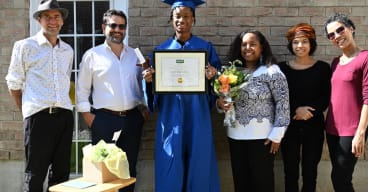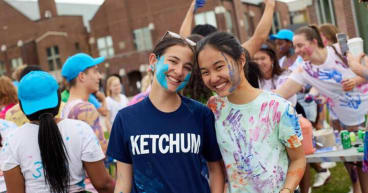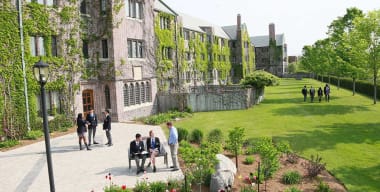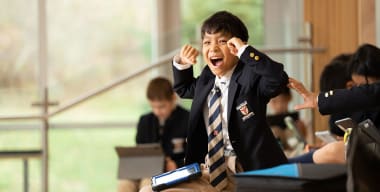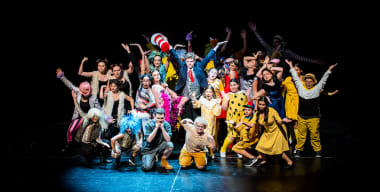"Excuse me, may I help you?" he inquires politely.
"Art room," is the invariable reply.
Listen to Christianne Lemieux, art teacher at The Study, a school half an hour away in Westmount: "What I really like about teaching here is that I have a terrific budget and small classes. It means I can really establish contact with my students."
What can they mean? From Newfoundland to British Columbia, we're used to reports of cutbacks in school arts and music programs so severe that art teachers, where they still exist, sometimes have to pay for art supplies out of their own pockets.
Lemieux, in fact, taught for a year in a Montreal public school, where she had to make up the shortfall in art materials out of her pay.
But that seems not to be the case at independent and private schools.
At four schools in Quebec - and at independent and private schools across the country - art and music programs are thriving. Consider:
- At Stanstead College, in the Eastern Townships, the music program has been revived after a 50-year hiatus, complementing the recently expanded suite of three art rooms, one a superb pottery room.
- At Bishop's College School, a gifted school in Lennoxville, Quebec, art teacher Myles Vivares can hardly wait for a school expansion project that will soon give him at least twice the space he has now, while the school's standout drama department will get a new theatre.
-Weston School, in addition to spending generously on art supplies, last year hired its first music teacher and has ordered up a double-sized pre-fab to expand its music program.
-Villanova College has a new on-site theatre to add to its rich arts programming.
At The Study, music teacher David Christiani, a former professional singer, rehearses his school choir in new quarters to die for - vaulted ceilings, light pouring through stained-glass palladium windows, rows of teaching keyboards.
These are not considered frills. Money is being spent on arts programs for hard-headed reasons.
Says Stanstead's music teacher, Eric Grenier: "There are enough studies now to show that music education increases early brain development and improves academic performance."
Anastasia Polito, the other music teacher at The Study, has just finished leading one of the school's four bands in the theme from Star Wars at an assembly. "Learning to play an instrument is a great discipline," she says. You learn to read a new language - musical notes. You learn styles, physical co-ordination, and you are emotionally involved, too.
"Beginning is hard," says Polito, a saxophonist, "and you can easily get discouraged. But once you get beyond that, there's a real feeling of achievement."
Jessica Davis, 15, a gifted musician who, like Polito, plays the saxophone, says her parents are impressed. "They wonder where I get the talent from."
Musical talent, it seems, is everywhere. It turned out that Sonia Wells, the wife of one of Stanstead's teachers, once sang with Montreal's Jubilee Gospel Choir, so she was a natural to conduct the choir. With the advent of the choir and Grenier's band, "music has changed everything here," says headmaster Christopher Shanon.
As you approach Weston School, a Montreal school that offers kindergarten to Grade 11 in a one-time office building next to railway tracks, even from outside you can hear music teacher and jazz trombonist Ian Hanchet leading an improv group in Mustang Sally, a James Brown standard.
"Music - it's a form of intelligence," says Hanchet, a former music therapist. "We are able to reach the whole child. We use musicality to access their humanity." And, he adds with a hint of pride, "I've really been able to light some fires."
But isn't art a soft option? Don't even ask the question around Christian Williams, who teaches art at Stanstead. "From the 1960s, art has had a flaky image as something undisciplined. We want to break down that stereotype," he says.
It's all about challenging youngsters. Using branches collected from the school grounds, Williams calls on his students to apply their architectural skills, designing miniature structures that allow for engineering stresses and aesthetics.
But art also allows for a breathing space. "It's like a casual thing," says Tim Riviere, 13, who's quietly weaving on a loom in Weston School. "I come up here thinking 'I'm going to have a great time.' If I'm having a bad day, it helps me to just relax."
At Bishop's, Vivares uses art to illustrate history, showing a class how the spectacular skies of the British landscape painter Joseph M.W. Turner were really the smoky result of the Industrial Revolution.
"Certainly," says Vivares, who was born in Manila and came to Canada as a child, "there is a lot more freedom and opportunity in the private schools. It's my experience that they regard the arts as an important part of the program."
For some students, that can mean conflict. Riddhi Desai, 14, says her art teacher has exposed her to a lot of new ideas and techniques in her first year at Bishop's. She's even more involved in the school's performing arts program, and was in a recent production of the play The Fantasticks.
"It's like a dream of mine, to go on Broadway," she confides. "But my dad's a doctor, and I know my relatives would say, 'You are a doctor or you are nothing.'"
Nancy Layton, Bishop's head of school, says an appreciation for the importance of the arts "is something on which we have to continue to work with parents. Riddhi has a wonderful voice. You have to wait to see what your potential is. We say, "Writing's cool, music's cool, art is cool.'"
At The Study, a girls' day-school with 400 students, David Christiani, winding up a percussion and singing kindergarten class acknowledges the same problem. "A private school can be competitive. The children are conditioned to compete. So you want to show them there are other ways - like all singing together in a choir. It's an awakening process, giving them those abilities they can carry on through their lives."
Or, as Tony De Melo, head of art at Weston, puts it: "Art helps people learn - and it's a de-stresser. Art makes people healthy. Same thing with music."
The Beatles tune Yesterday provides a lulling background in Vivares's art room, which looks out over the trees around the sports field. He's been talking to his students about Renaissance skies as they work on their projects. "I like what's happening here," he says, "not just professionally, but what the kids are getting here - day in and day out."

